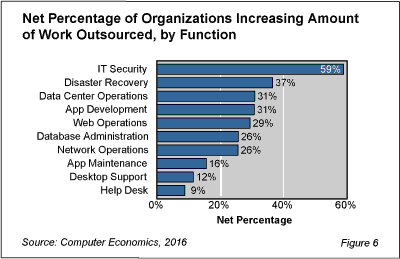IT departments are facing an increasingly varied and growing number of threats, and they are responding to that challenge, in part, by increasing IT security outsourcing in the coming year.
The recently released Computer Economics IT Outsourcing Statistics 2016/2017 study finds that a majority of IT departments surveyed were planning on increasing the amount that they plan to outsource IT security.
As shown in Figure 6 from the study, we present the net growth trend, ranking the functions by the percentage of organizations that plan to increase the amount of work they outsource minus the percentage that plan to decrease the amount of work they outsource for each function. IT security leads the way with a net of 59% of organizations planning to increase outsourcing of this function.

Perhaps just as telling for the growth of the IT security outsourcing outlook is that no organizations reported planning a decrease in the amount they were outsourcing. “As threat vectors change and become more sophisticated, more specialized skills are required to protect an organization,” said David Wagner, vice president of research for Computer Economics, Irvine, Calif. “Also, many organizations are changing strategies from primarily threat prevention to threat detection which requires another skill set. IT departments are responding to this need for a wide variety of specialized skills by outsourcing more.”
Here are other key findings from our IT Outsourcing Statistics study this year:
-
Outsourcing is becoming more attractive to smaller organizations. As a percentage of the IT budget, small organizations this year are outsourcing at about the same level as larger organizations. There are several factors encouraging this trend, the greatest of which is the willingness of service providers to go downmarket with more cost-effective and scalable offerings. The popularity of cloud and hosted solutions for small companies also is driving this trend. Small organizations are now spending 6.7% of their IT budget on outsourcing at the median this year, not much different from the 6.3% for large organizations.
-
Application development is the most frequently outsourced function in the study, and 40% of organizations that outsource this function are planning to increase the amount of work they outsource. Application development continues to take larger parts of the IT budget, and many IT departments are looking to optimize internal staffing through selective use of outside development firms.
-
Organizations that outsource are favoring help desk and disaster recovery as functions where they are moving the largest percentage of work to outside service providers.
-
The IT functions with the greatest potential for successfully reducing costs through outsourcing are help desk, desktop support, network operations, and data center operations.
-
The functions with the greatest potential for improving service through outsourcing are IT security, disaster recovery, and web operations.
- The outsourcing of desktop support, disaster recovery, and database administration deliver the best value. The outsourcing of these functions can save money and improve service levels.
In the full study, we profile outsourcing activity for 10 IT functions: application development, application hosting, application maintenance, data center operations, database administration, desktop support, disaster recovery services, help desk services, IT security, network operations, and web operations.
For each IT function, we measure the frequency and level of outsourcing. We also look at the current plans of IT organizations to increase or decrease the amount of work they outsource. Finally, we examine the customer experience to assess whether organizations are successfully lower costs or improving service through outsourcing.
This Research Byte is a brief overview of our report on this subject, IT Outsourcing Statistics 2016/2017. The full report is available at no charge for Computer Economics clients, or it may be purchased by non-clients directly from our website (click for pricing).

